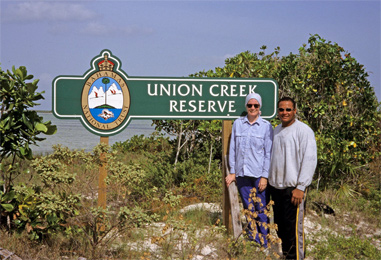Long-lived species require long-term research. Sea turtles are slow-growing and long-lived. Sexual maturity is attained only after decades and natural life expectancy approaches a century. As a result, studies on the biology and conservation of these species must also stretch over decades.
The vast majority of sea turtle studies has been conducted on nesting beaches where females come ashore to lay their eggs. This short but critical period is the time when sea turtles are most accessible to biologists. In addition to beach studies, we have focused our efforts on in-water studies, where turtles spend about 98% of their lives.
Many of our research projects are conducted at three long-term study sites:
Union Creek Marine Reserve, Great Inagua, Bahamas
Union Creek Marine Reserve, Great Inagua, Bahamas, is a foraging ground for immature green turtles and hawksbills. In cooperation with The Bahamas National Trust, we have studied these populations since 1974 and have assessed a wide range of topics including digestion, nutritional ecology, foraging behavior, growth rates, survival and emigration probabilities, source rookeries, and genetic diversity. This study has been very productive, yielding many “firsts” in building our understanding of sea turtle biology over their foraging grounds and away from the nesting beach.
Azores, Portugal

The waters around the Azores, Portugal, on the mid-Atlantic ridge are foraging grounds for the early life stage of loggerheads. Since 1989, in cooperation with the Department of Oceanography and Fisheries, University of the Azores, we have evaluated source rookeries, growth rates, survival probabilities, and foraging ecology of these loggerheads. Because the turtles in this region are threatened by incidental capture in longline fisheries targeting swordfish and sharks, we studied the effect of gear modification on reducing bycatch of turtles.
St Joseph, Florida
St. Joseph Peninsula in the Florida Panhandle has been the site of ongoing ecological study since 1994. Its beaches are among the fastest eroding in the state, yet it supports the largest nesting assemblage of the genetically distinct Northwest Florida loggerhead subpopulation. Our continuing studies of this population include evaluation of demographic factors and responses to climate change, as well as the effects of anthropogenic impacts such as beach driving, lighting, recreation and beach nourishment. The Peninsula encloses St. Joe Bay, which our mark/recapture work since 2000 and subsequent cold stunning events have established as a major juvenile green turtle developmental area in the northeastern Gulf of Mexico. The recent Deep Water Horizon Oil Spill in the Gulf has the potential to impact both the aquatic and terrestrial areas of this study site and has given our work there increased prominence and urgency.

